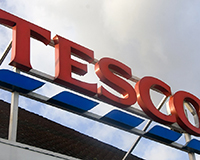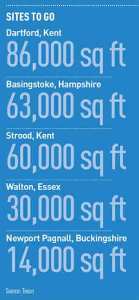 Every little helps. Faced with a £4.7bn writedown in the value of its property portfolio – including £925m for developments that will not now go ahead – selling off its Hertfordshire HQ and half a dozen prime South East development sites must have seemed to Tesco bosses like an excellent idea.
Every little helps. Faced with a £4.7bn writedown in the value of its property portfolio – including £925m for developments that will not now go ahead – selling off its Hertfordshire HQ and half a dozen prime South East development sites must have seemed to Tesco bosses like an excellent idea.
As the process of unloading its unwanted South East assets begins in the wake of the firm recently posting record £6.4bn pre-tax losses, Tesco exudes a grocer’s optimism. But it could be in for some surprises if the fate of its Basingstoke site is any guide.
In January, Tesco abandoned its plans for a new 63,000 sq ft store at Brighton Hill, Basingstoke, one of five major development plans dropped in the South East and 49 dropped nationwide. In all, Tesco is dumping plans for around 2m sq ft of new retail floorspace.
The decision to scrap the scheme on a former industrial site at Winchester Road ended eight years of planning controversy. With three supermarkets in the neighbourhood and roads already congested, the local consensus was that alternative uses might be preferable. Two planning applications had already come to grief and a third looked like it was heading the same way. The local Conservative MP and prospective Labour councillor joined in the applause for Tesco’s decision to drop it.
 Tesco is thought to have paid about £16m for the site as the boom peaked in 2008. Few expect it to see half its money back, and some think even half would be amazingly good. Since the scheme was due to include 48 homes – perhaps a sale to a residential developer is the answer?
Tesco is thought to have paid about £16m for the site as the boom peaked in 2008. Few expect it to see half its money back, and some think even half would be amazingly good. Since the scheme was due to include 48 homes – perhaps a sale to a residential developer is the answer?
Jim London says selling the site is not going to be easy.
“It backs onto a retail park, and although it fronts a main road you would need vehicle access from the back. It is not really a quality area for residential, and it is close to the town centre, which has already had a lot of flats built. Residential land values would not be huge,” he muses.
“It would be good for industrial, which is what it was before, but you would maybe look at under £1m for an industrial site. It is a bit out of the way for offices. It’s a curate’s egg.”
If the problem of curate’s egg sites was limited to Basingstoke, Tesco could laugh it off. But according to Tesco-watchers, the problem of overpriced, unattractive sites is by no means unique.
Tom Edson, director of out-of-town retail at JLL and the firm’s head of supermarkets, says: “The big four grocers are highly unlikely to look at the ex-Tesco sites – and their pipelines are full for the next three years anyway. The most likely option is residential, but when you get down to specific sites you discover they were not chosen for their suitability for resi development, and residential and retail won’t necessarily mix. On the whole, they are challenging sites. It is all a question of how big a hit they want to take.”
Some sites obviously have better residential potential than others. For instance, Tesco planned 30,000 sq ft on a former caravan park at Walton-on-the-Naze, Essex. The site next door is already being developed for housing by Taylor Wimpey. But even in a high-value residential area like the South East, not all sites lend themselves to housing development.
Tesco said in a statement: “We are actively marketing our sites and working with local authorities to find appropriate alternative uses. Alternative uses could include a range of uses depending on the nature of the location and we will consider all options.” A spokeswoman for GL Hearn, understood to be advising on the Basingstoke site, said: “We do not have any information.”
Experts say there are more South East sites and stores on Tesco’s hit list, and that further announcements are inevitable. City firm Cantor Fitzgerald says 200 underperforming stores are still to go as the firm cuts away 2.7m sq ft of unwanted floorspace.
Heiner Evanschitzky, professor of marketing at Aston Business School, says: “These sites were basically only good for supermarkets, but none of their rivals will want them, and in the South East this presents them with a big headache. They got overexcited in the South East, grabbing sites.”
David Gray, analyst at Planet Retail, says: “There are a lot more closures and abandoned schemes to come – at least as many as they have already announced. Tesco may get some value from sites converted to residential use, but that needs planning permission, and often the sites aren’t suitable. It will take years for them to earn on this portfolio.” Tesco has always prided itself on its ability to sell. Getting rid of its unwanted South East sites could test that ability to its limits.
Tesco would prefer not to sell its Hertfordshire HQ
 The supermarket giant has instructed DTZ to find tenants for the 147,000 sq ft New Tesco House, on Delamere Road in Cheshunt. The quoting rent is £17.50 per sq ft for the 42-year-old building – good value in anyone’s book, says DTZ senior director Jamie Renison.
The supermarket giant has instructed DTZ to find tenants for the 147,000 sq ft New Tesco House, on Delamere Road in Cheshunt. The quoting rent is £17.50 per sq ft for the 42-year-old building – good value in anyone’s book, says DTZ senior director Jamie Renison.
The old Tesco House next door – about 15,000 sq ft – is not yet on the market, but will be soon. Tesco has four separate freehold sites, and one leasehold, at Delamere Road.
Tesco will vacate in 2016, downsizing into its 35,000 sq ft offices at Shire Park, in Welwyn Garden City. “Occupiers like Metrobank are looking at Croydon, but they should be looking at this building, too,” says Renison. “We have been tasked to find a tenant. I guess we move onto the freehold sale if there is no tenant, or an occupier only wanted to buy freehold.”
No sale price is being disclosed, but around £15m is thought to be plausible. “Tesco is not a forced seller,” Renison cautions. “And I don’t see this site going for residential. It is worth more than its land value, even if you assume £2m an acre.”










